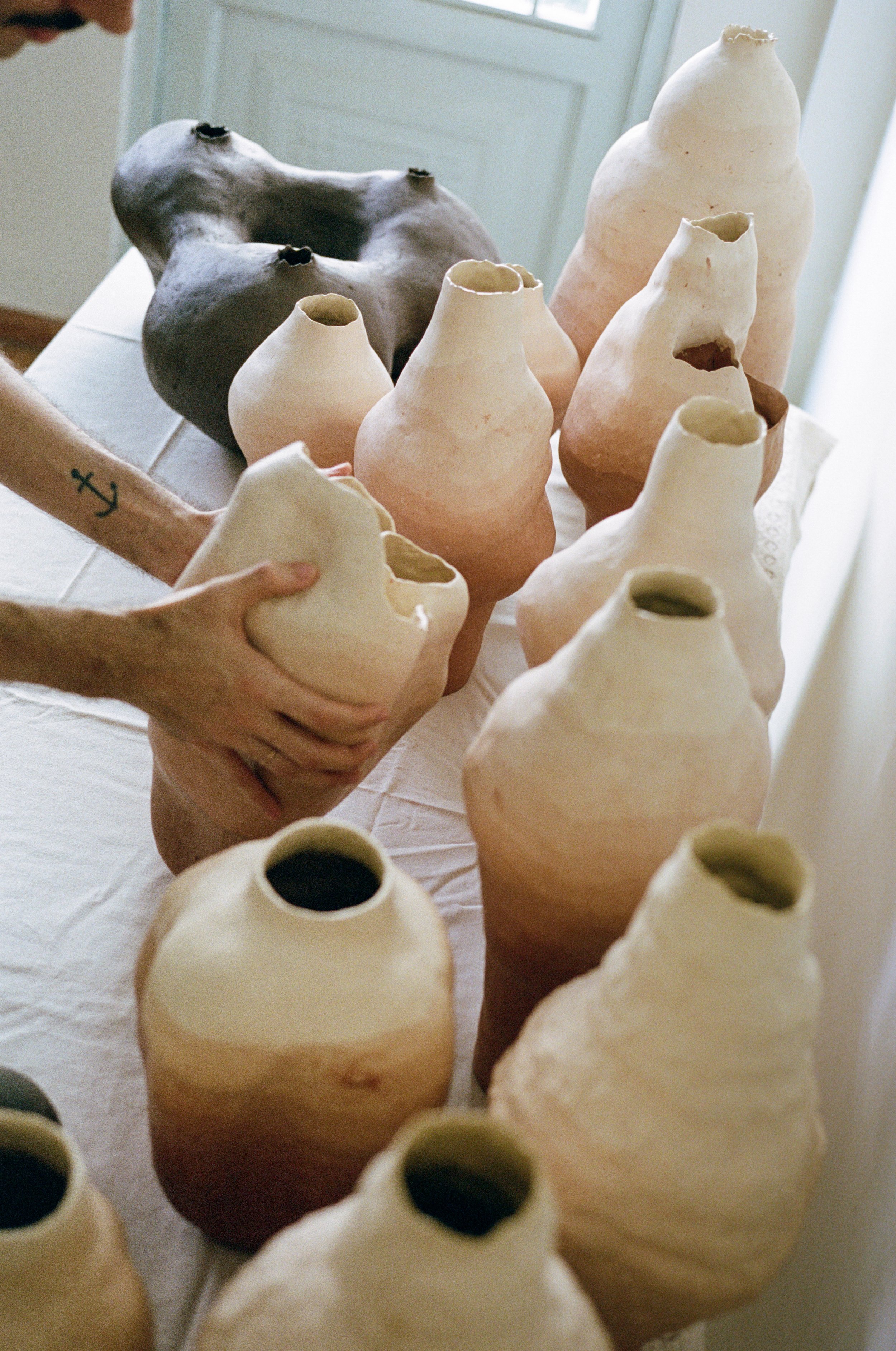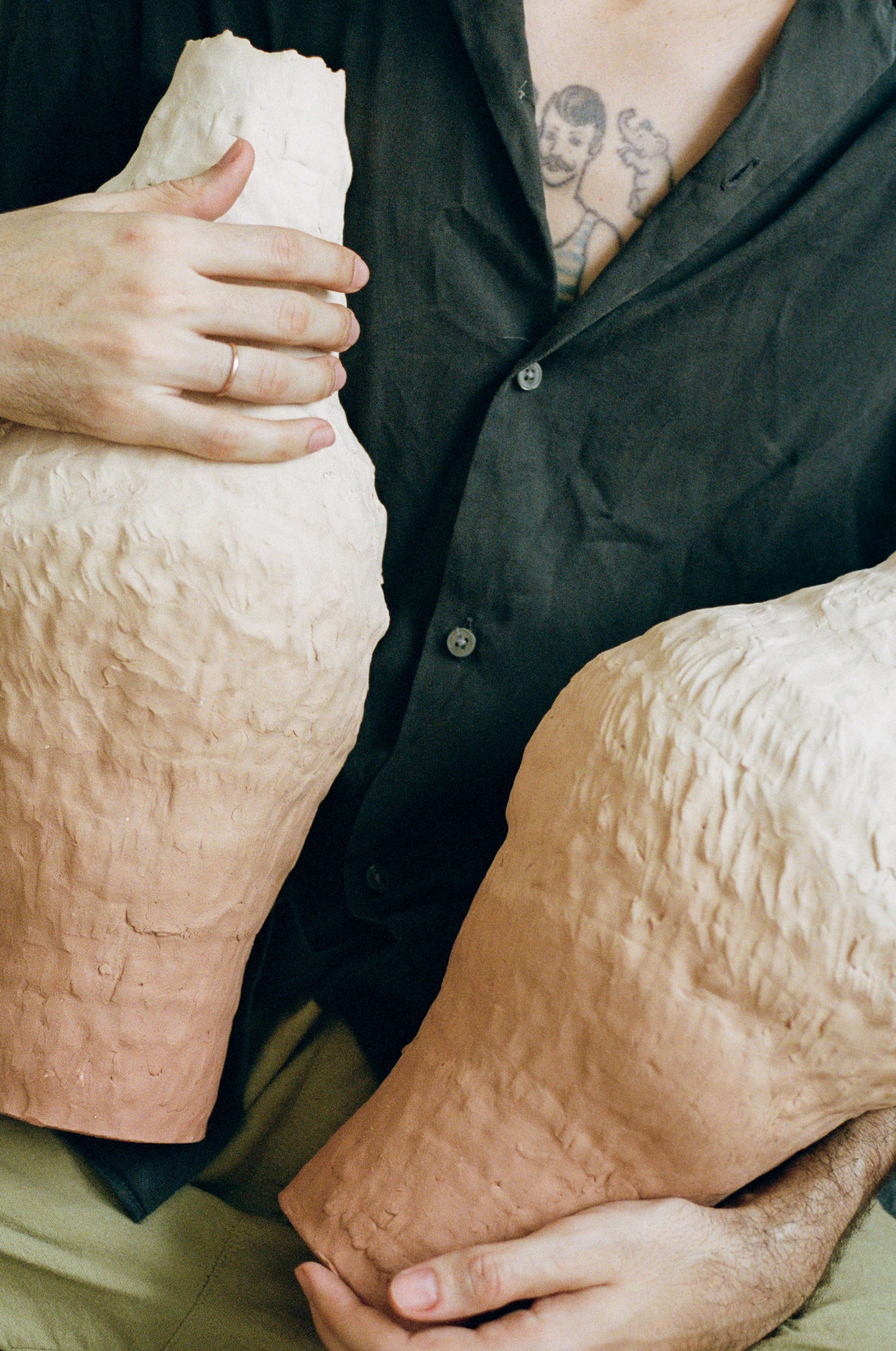Leandro Marcelino, born 1987, is a multidisciplinary artist from Tenerife, Spain who works with ceramics as his main medium. He left the Canary Islands by age 20 and lived in various cities across Europe before uprooting to Saigon, Vietnam in 2012. What began as a hobby to pass the time became a 10-year practice and the establishment of Hey Camel Ceramics, the first handmade ceramics store in Ho Chi Minh City.
Leandro invited me to his studio and we spent the day discussing goals, influences and how he had been nursing two stray kittens back to health. I looked around – the walls were adorned with paintings and black and white family photographs. Stacked on shelves and cabinets were pieces yet to be fired, vases to be admired, glazes, sample swatches, and mugs he had made, collected, or gifted from a pet shop he visits. At one point, I noticed him drinking from three different mugs, taking a sip from each as he moved swiftly around the room.
The sunlight flooded the space one minute and retreated the next. He shared stories over hibiscus tea and fresh-cut pineapple topped with cayenne pepper; each bite was packed with sweetness and a spicy kick, like the artist himself. He showed me his favourite ceramic pieces and we lost ourselves in a conversation about accepting and embracing imperfection and less-than-ideal outcomes. Over time, it became clear to me that it is in this way that Leandro approaches not only his art, but also life, giving way to happy accidents and beautiful moments. Read on for more from Leandro Marcelino.
So, how did you get into ceramics?
I arrived from the UK and I didn’t know what to do so I started trying workshops at this Japanese studio. After some time, I applied to work with them as an assistant and after a while the owner wanted to take more free time for himself so I took over the classes and the ceramics course. It was a big company. We were 5 or 6 people. The owner got sick so he had to go back to Japan and close the place. Because I was selling ceramics at the time and people were actually buying my pieces, I was like, “Oh, let me see if I can open my own studio.” I rented a little space and it’s been 10 years since.
Wow. You’ve been in Vietnam for 10 years?
More. This year is 12.
What’s your favourite thing to make?
Vases and tea bowls or ikebana planters.
Do you usually begin with a sketch or do you dive in right away and see what happens? What’s your process like?
I look at old ceramic books or magazines and get inspiration from there, then I adapt it to what we can do here with local materials. Sometimes I like to experiment and see what happens. I normally make different silhouettes and I might like the shape from this piece but like the shape from this other piece so I put them together. But it depends. There are restaurants I work with who order custom pieces so I need to work with what they want and whatever references they have.
When you’re viewing a ceramic piece, what do you see first? Do you notice the silhouette, colour or is it more tactile like the texture?
I think for all ceramists you first look at the technique. You think about how it was made, how the clay was used and how the glazes and colours were applied. Obviously how pretty it is, but it’s relative. Sometimes I don’t care about how it looks. I care about how it was made because I get curious and wonder, “How did they do that?”
For your first exhibition, Landscape Gradients, you used a technique learnt from the Canary Islands. Do you often draw techniques from home?
I lived in Tenerife but I used to summer in this small town on another island, La Gomera. I learnt this ancient technique called Alisado where you use one single stone to rub the surface of a ceramic to make it smooth. Actually, this technique is not only present in the Canary Islands but in all the populations in Africa. It’s an old style of making pottery so there is a correlation there that confirms that we, Canarians, come from Northern Africa. So it’s part of an identity that has surpassed the Spanish colonization and has passed down from generation to generation. That is why I wanted to use it because it is very personal.
Is your work heavily influenced by your birthplace or Vietnam?
I think both. I will say that I am Vietnamese-inspired, the technique is Japanese but my heart is always Canarian. It’s a mix of all of them.
That’s beautiful.
For Landscape Gradients, I grew up on a Volcanic island in the South so it’s very dry with no trees and lots of lava rock. We used to play in caves pretending it was our secret bunker like in the movies. This is what kids did growing up. There weren’t many options out there. So this is represented by the piece with the three vases. I built it thinking of the empty space inside rather than the surface outside. They’re called lava bombs. So when the lava cools down, it will create a hollow surface. If you reduced yourself to a miniature and you go inside, for me that was the experience that I had with the caves.
That vase is a reflection of your childhood.
Yeah, kind of.
Do you have any goals for your work right now? Are you working with a destination in mind?
Yes!
That was a confident yes!
In 2026/2027, it will happen!
What will happen?!
Anything!
“It will happen!” I love that.
That’s my goal. This year, I want to collaborate with creators and galleries in a more professional setting. The year after, I want to master my craft more and go international. My goal is to participate in contests and residencies to grow my knowledge in the art field.
So, in a couple of years, you want to apply for these opportunities?
It’s my goal. There’s this painter, Yves Klein, who painted a frame that’s just blue. So it’s pretty but you cannot understand the work unless you know the story behind it. When you start digging into it you find that the artist created this monochrome pigment, a new shade of blue called Klein Blue, and that’s his signature. Behind each brush stroke is a trained hand and a deep understanding of materials. This painting showcases the maximum expression of this artist and how pure it is. There’s a method, technique and story behind it. It’s the mastery of craft. So it’s not about winning contests but to master my craft to be at this level.
I want to say as well that I have waited so long to become an artist because I always ask for the best of myself. I try to make the best art I can. During this last decade, I’ve been working on my techniques. Practicing and practicing and practicing until I can confidently manage how the clays mould and how it reacts to my hand to give it certain shapes. So now I’m more free with my work and can express what I want to express. But it’s also a personal lesson in accepting what is meant for you.
What do you mean by that?
For Landscape Gradients, there are two vases without the Alisado technique. I had a personal emergency and I was in the hospital for three weeks so by the time I returned home, it was too late. The pieces had already dried completely. Instead of disposing of them, I embraced the moment and decided to include these artworks in the collection as a reminder to myself to learn to see difficult moments in life and make them beautiful.
That’s a lesson I’m personally still learning. It applies to your art but it’s also a universal lesson for life.
Exactly. And sometimes you make something that’s half done or not meeting your standards but at least you got to make it and express yourself.
Have you always been so open-minded and able to accept whatever the outcome?
I’m always very specific with what I want and I’m ready to reach my goal in whatever way. I’ve just learnt how to accept it even if it’s not perfect because perfection does not exist.
That’s a hard thing for people to learn, including myself.
I think it has to do with experience and maturity even though I’m only… 25 years old! Did you record that?!
Yes, 25 years old!
I’m sure in 10 years I will think, “What the hell was I talking about? I was so blinded by what I thought at that time!” I’m sure as you mature you will see all the points of beauty and accept things for what it is because that is life. We’ll find out.
We’ll find out. Report back in 10 years!
Hopefully!
Instagram. @leandromarcelino.art @heycamelceramics
Website. www.leandromarcelino.com
Vulnerable Works is about the quiet courage of making. At its core, this project is deeply personal. Through these conversations, I seek perspective and ways to navigate feelings of doubt, uncertainty, and the tension between vision and reality. These stories weave my reflections with those of the artists, offering a glimpse into the process, the trust it demands, the triumphs that keep us going, and the vulnerability inherent in creating. Sometimes I pick up a little more—the songs that fill artists’ studios, bits of their daily routines—but always, I return with photographs.



















